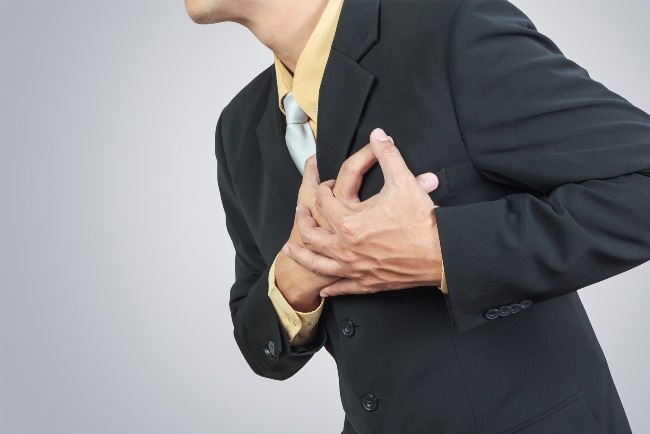Arrhythmia, a disorder that occurs in the heart rhythm.
Arrhythmia is a disorder that occurs in the heart rhythm.
Arrhythmics can feel their heart rhythm too fast, too slow, or irregular.

Actually normal arrhythmias occur in a healthy heart
condition. But if it occurs continuously or repeatedly, arrhythmias can
indicate a problem with the heart organ.
There are several
types of arrhythmias that are most often found, namely:
Atrial fibrillation, which is a condition when the heart
beats faster and irregularly.
AV block, which is a condition when the heart beats slower.
Supraventricular tachycardia, a condition when the heart
rate is too fast.
Extra systole ventricles, which are conditions when there
are other pulses outside the beat
Ventricular fibrillation, which is a condition when the
heart just vibrates.
Symptoms of
Arrhythmia
Arrhythmia can occur without causing symptoms, so sometimes
it is not realized by the sufferer. Symptoms of arrhythmia that can occur
include:
The heart beats faster than normal (tachycardia)
The heart beats slower than normal (bradycardia)
Dizzy
Passed out
Get tired quickly
Hard to breathe
Chest pain
Keep in mind, someone who experiences the above symptoms may
not necessarily have an arrhythmia. Therefore, an examination by a doctor is
needed in order to find out what triggers these symptoms.
When to see a doctor
Perform routine health checks to the doctor, especially if
you have hypertension, thyroid disorders, diabetes, heart disease, or have had
heart surgery.
Immediately to the doctor if you often experience chest
pain, shortness of breath, and heart palpitations, especially if the complaint
appears suddenly.
If someone collapses after complaining of the above
symptoms, immediately take it to the emergency room at the nearest hospital.
Causes of Arrhythmia
Arrhythmia occurs when electrical impulses that function to
regulate heart rate do not work properly. These conditions can be caused by a
number of conditions below:
Take a cold or allergy medicine
Sleep apnea
Hypertension
Diabetes
Electrolyte disturbances, such as excess or lack of
potassium.
Thyroid disorders, for example hyperthyroidism
Heart valve abnormalities
Congenital heart disease
Coronary heart disease
Heart attack
In addition to
medical conditions, arrhythmias can also be triggered by unhealthy lifestyles,
such as:
Cannot manage stress well
Lack of sleep
Smoke
Excessive consumption of alcoholic or caffeinated beverages
Drug abuse
Arrhythmia Diagnosis
To determine whether the patient has an arrhythmia, the
doctor will ask for symptoms and listen to the patient's heartbeat. After that,
the doctor will do the following checks:
Electrocardiogram (ECG), to record the electrical activity
of the heart while lying down. In order to record the electrical activity of
the heart when the patient is active during the day, the doctor will install a
portable ECG device called a holter monitoring on the patient.
Cardiac exercise test, to measure heart activity when the
patient is doing physical exercise, for example pedaling a static bicycle or
walking on a treadmill.
Echo of the heart, to see the structure and function of the
heart. This procedure is carried out with the help of sound waves.
The doctor can also carry out other examinations, to see the
possibility of an underlying disease of arrhythmia, namely:
Measurement of electrolyte levels
Measurement of blood sugar levels
Imaging
Cardiac catheterization
Biopsy
Treatment for
Arrhythmia
The treatment for arrhythmias aims to treat irregular heart
rhythms. The method used depends on the type of heart rhythm disorder, whether
it is too fast or too slow.
Arrhythmia treatment
methods include:
Drugs
Medications prescribed by doctors to treat arrhythmias are
antiarrhythmic drugs. The doctor will also prescribe warfarin to reduce the
risk of blood clots.
Ablation
Doctors perform cardiac ablation by installing one or more
catheters in blood vessels that lead to the heart. Electrodes located at the
end of the catheter will destroy a small portion of tissue in the heart that
causes heart rhythm disorders, so the heart rhythm becomes normal again.
Pacemaker
The doctor will install a pacemaker under the skin, just
below the collarbone. The pacemaker functions to restore heart rhythms that are
too slow to be normal.
ICD
Implantable cardioverter-defribilator (ICD) is a small
device that is placed in the chest. This tool is used in patients who are at
risk of sudden cardiac arrest. This implant will detect heart stops and
automatically conduct electricity to overcome them.
Complications of
Arrhythmia
In some cases, arrhythmias can worsen and cause serious
complications, such as:
Dementia
Alzheimer's disease
Stroke
Heart failure
Sudden cardiac arrest
Sudden death in infants (SIDS)
Prevention of
Arrhythmia
As explained above, many factors cause arrhythmias.
Therefore, the prevention depends on the cause of the arrhythmia. In general,
artistry can be prevented by maintaining heart health, namely by:
Quit smoking.
Eat healthy food.
Maintain ideal body weight.
Exercise regularly.
Limit consumption of alcoholic and ber drinks
Avoiding drug consumption without doctor's instructions.
Patients with heart disease need to do regular control to
the doctor so that the condition of the disease does not worsen and cause
arrhythmias. Patients also need to take medication regularly as directed by the
doctor, and immediately see a doctor once symptoms worsen.
0 Response to "Arrhythmia, a disorder that occurs in the heart rhythm."
Post a Comment